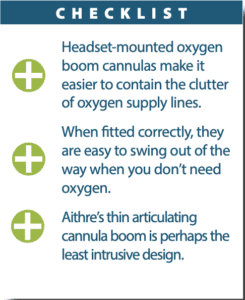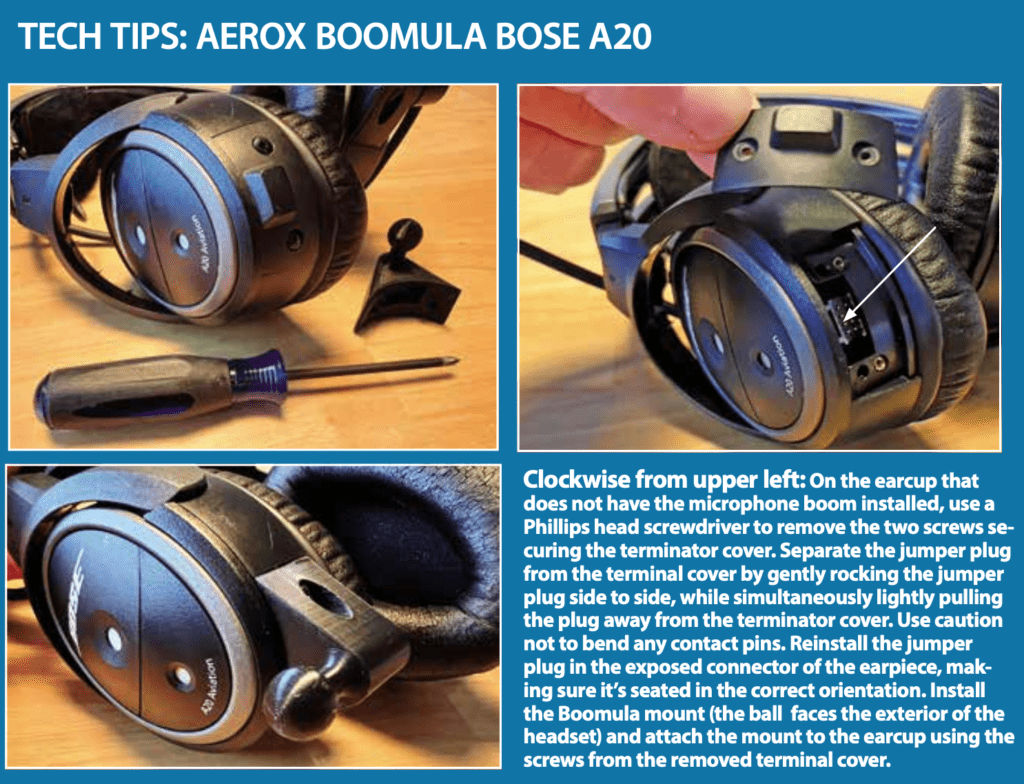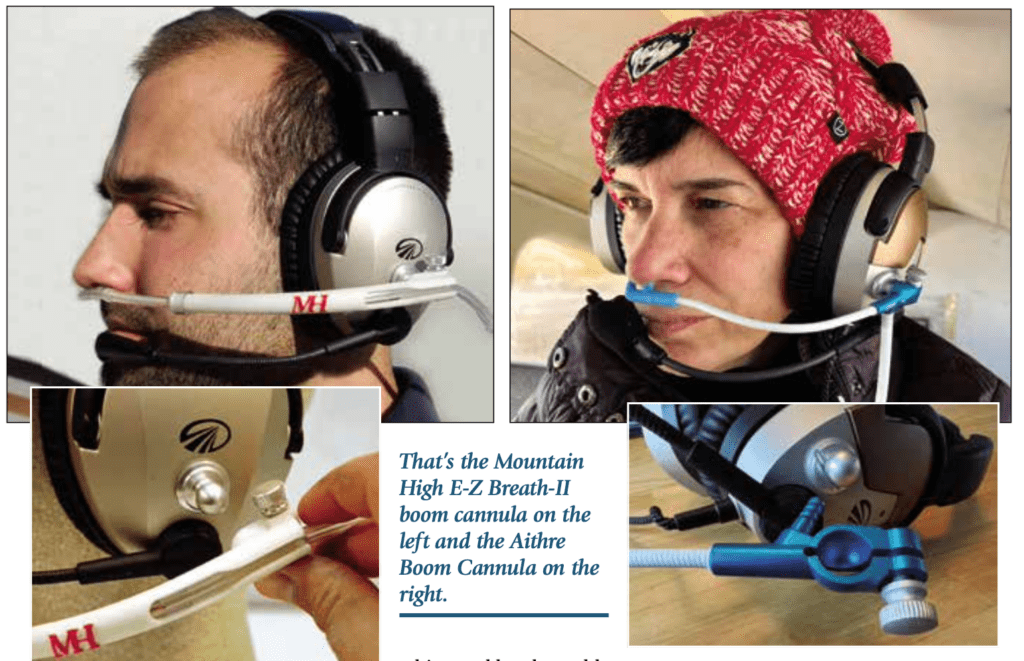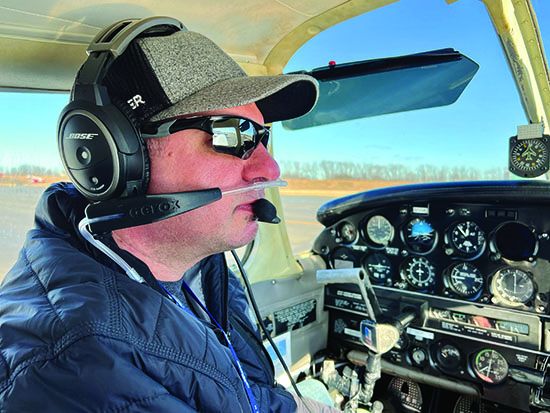Ballcap, eyeglasses, headset and oxygen cannula. That’s a mess of accessories on a pilot’s and passenger’s heads. And it’s that head clutter that might make lots of us skip the use of supplemental O2 simply to avoid a nose cannula, even at the price of hypoxia.
About the only other thing you can do shy of buying a pressurized airplane is trying a headset boom cannula. I tried three of them—one from Aerox, another from Aithre and the one from O2 system veteran Mountain High. I think they’re all OK and a better option than anchoring the O2 supply line over the ears.
UNRULY NOSTRIL TUBES

If you’re new to portable O2 systems, don’t overthink it, and certainly consider using one even at low altitudes. You’ll likely feel better. Since the FAA allowed cannula use somewhere around 1982, and now with personal-sized compact lightweight oxygen bottles and oxygen-saving flowmeters, O2 gear has become a big market.
It’s the same and as simple as it ever was; a conventional cannula is little more than two short surgical tubes stuck in each nostril, with the other end connected to a main supply line. Cannulas are relatively inexpensive and easy to replace when they get nasty.
For some, especially inexperienced and uptight passengers, wearing the getup (or at least putting it on) can be a chore. There’s fiddling with the supply line that generally goes over the ears, and then the nostril tube line is positioned in place, and when done correctly, stays in place while the wearer forgets it’s there. But anchoring the nose tubes on a headset boom that’s connected to one of the headset’s earcups is supposed to make it all easier to manage. There are obvious advantages. Using a ball-and-socket mount, you can easily swing the cannula away from the nose, and then quickly stick it back in when you need more O2. Let’s go to the bench and install some on a Bose A20 and Lightspeed Delta Zulu headset.
AEROX BOOMULA
The new Boomula from Florida-based Aerox can work with any traditional-shaped headset, replacing the “mustache” cannula. The Aerox conserving pendant feature attaches to the boom, and also connects to any existing flowmeter/needle valve for universal use. The plastic boom comes with a universal stick-on ball-and-socket mount, plus a hard-mount assembly for attaching to the Bose A20 headset.
When attaching to the Bose headset, read the instructions. Carefully. I didn’t, and simply removed the jumper cover (the jumper connector is a way to configure the headset for either a left- or right-cup mounted microphone) and screwed the Aerox mount in its place. I then went flying to find I only had headphone audio in the left ear—the earcup the microphone is mounted to.
The right way to do it is to remove the cover, relocate the jumper back into the earcup and then attach the mount. That restored the audio on my set. I asked Aerox principal Scott Ashton if Bose is in approval with this configuration and he said the company is aware of the product and doesn’t object to the modification. If you have to send the set back to Bose for service, I would remove the Boomula mount in case the company swaps out the headset or simply removes the mount during service.
Since the Boomula (when hard-mounted to the Bose) doesn’t quite sit at a 90-degree angle to the nose, you’ll likely have to adjust the cannula’s tube length (you have a couple inches of travel) so it stays in the nostrils. It doesn’t need to go in far. The universal ball mount that simply sticks to the earcup might offer a better adjustment for some heads.
I tried the setup with the Aerox 1A portable oxygen system with the OxySaver pendant with flowmeter/needle valve. The boom and mount are made well, and in Aerox tradition, the company was easily accessible for help during assembly. Contact www.aerox.com.

AITHRE BOOM CANNULA
Priced at $150, the Aithre Boom Cannula is made for a universal fit and comes with a ball-and-socket mount (Aithre calls it a knob) that sticks to the side of a headset earcup. The kit includes a silicone cannula, boom arm, mount knob, pivot adapter, thumb set screw and two removable 3M adhesive pads.
The thin articulating boom arm feels like a mini microphone boom, and Aithre said the adhesive it selected to hold the anodized aluminum ball in place is strong enough to stick, but can also be removed. It fit we’ll on a Lightspeed Delta Zulu headset, and it would be easy to replace the silicone cannula when it gets old. No tools required. Aithre points out that unlike PVC cannulas, silicone maintains flexibility even at low temperatures, and I found it easy to get a decent fit.
I wish I could get the arm to slide farther into the adapter so it’s more secure, but the sheathing on the boom bunched up and kept it from sliding in farther. If you manhandle the headset, as I do, the boom might come out and mine did once. I tried the Aithre with the company’s composite personal-sized tank setup and found it easily adjustable for a decent fit.
There’s a small notch in the knob mount that’s intended to secure Aithre’s Illyrian oximeter cable. This wired SpO2 sensor can attach to the forehead or on the ear (fitting under the headset earpad), and the knob mount provides tension relief so you can wear the always-on oximetry. The sensor is part of Aithre’s biometric suite of products and works with the Aithre Connect app that’s compatible with iOS devices (including Apple’s Watch), plus experimental avionics displays including the Garmin G3X Touch, Dynon HDX and Advanced Flight Systems screens.
Contact Washington-based Aithre at www.aithreaviation.com.

E-Z BREATH-II BOOM CANNULA
Oregon-based Mountain High Aviation Oxygen Systems has been around since 1985 and you might know the company for its electronic pulse demand O2 delivery system.
I tried the second-gen E-Z Breath-II boom cannula on a Lightspeed Zulu headset, where it attaches with a ball mount using an adhesive pad. Mountain High said the boom works with just about every traditional headset, and redesigned the arm to incorporate an adjustable friction lock. This keeps the arm from slipping. The arm is designed to work on the left or right earcup of the headset. If I had to choose, I’d want any universal mount installed on the earcup that houses the headset’s cable. This way, the cannula tubing and headset cable can be routed in the same area, helping to reduce cockpit clutter. Of course, you’ll also want to consider where you’ll store the oxygen tank (or plug into a built-in oxygen supply).
The E-Z Breath arm can be easily removed from the headset when not in use, and Mountain High also offers an optional quick disconnect for the oxygen supply feed tube. The E-Z Breath cannula kit comes in various versions. There is the boom cannula that works with XCP flowmeters (Mountain High and constant-flow systems), the version that works with Mountain High’s EDS pulse-demand system with one-touch connector and also a version that works with earlier in-panel (IP) connections using a bayonet quick-lock connector. All styles are $99.00, plus Mountain High sells replacement cannulas for $28.50.
You can also purchase individual components to grow your own system. The E-Z Breath-II boom cannula alone is $59.95 and the adapter post (ball mount) is $9.95. I found the second-gen E-Z Breath-II boom cannula to be sturdy, we’ll constructed and a good value for the price. It’s been awhile since I tried the first-gen boom from Mountain High, but the latest version with the friction lock is a good improvement to better hold it in place—the main objective of any cannula boom. Visit www.mhoxygen.com.
TRY ‘EM OUT
Thankfully these gadgets don’t cost a lot of money and I think they are worth trying if you struggle with unruly cannula setups.
Aithre’s thin microphone boom-like cannula boom seems the least intrusive of the group and I like the smart notch that’s machined in the ball mount to house the company’s wired pulse oximeter.
For Bose A20 users, Aerox did a decent job with the hard-mounted Boomula mount, but I’m not convinced the included universal ball mount can work better for some faces. You can always try them both, but on an A20, there isn’t much room to mount the ball given the position of the cup-mounted ANR speakers.
With Sun n’ Fun and AirVenture coming up, I think it pays to get a hands-on demo to see what might work best for you.





